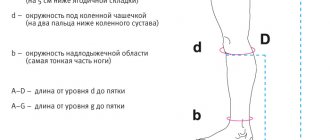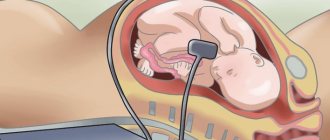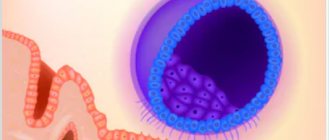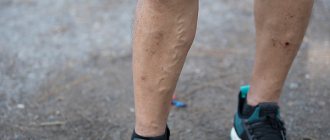Causes of varicose veins
- Weakness of the venous wall - congenital or acquired.
- Venous valve insufficiency – acquired or congenital.
- Obesity.
- Prolonged stay in a sitting or standing position due to the nature of the profession.
- Repeated pregnancies, intoxication, excessive physical activity, injuries.
- Taking contraceptive hormonal drugs.
If varicose veins appear, you should consult a specialist.
Varicose veins can only be diagnosed by consulting a surgeon or phlebologist. Examination and duplex scanning of the veins are usually sufficient to make a diagnosis.
- The expansion of the veins leads to deformation of the labia.
- In areas affected by varicose veins, dry skin and discoloration are observed.
- Vascular nodules and asterisks appear.
- You may experience discomfort, itching, a feeling of heaviness and, sometimes, pain.
- The skin is irritated, dilated, protruding veins are visible.
- You may experience discomfort during sexual intercourse.
What happens if varicose veins are not treated before pregnancy?
Varicose veins are dangerous due to serious complications:
- falling or frequently appearing swelling,
- compaction of the subcutaneous layer, cyanosis of the legs,
- thrombophlebitis, veins become bulging, bulging bruises appear,
- the appearance of severe itching, pain, and subsequently ulcers on the legs,
- weakness in movement, legs feel heavy, unliftable,
- thinning of the skin, every scratch leads to bleeding.
Every expectant mother is obliged to monitor her well-being, because it is during pregnancy that the risk of varicose veins increases, and this leads to many consequences, the worst of which is death during childbirth.
A sign of varicose veins is the appearance of dark vessels.
Varicose veins during pregnancy are accompanied by five forms:
- Deterioration of vein walls. Characterized by discomfort, fatigue, pain in the legs, swelling, bruising.
- Damage to the genital organ. The vessels in the groin area begin to swell. Abnormal discharge is observed periodically or constantly.
- Venous congestion syndrome. Characterized by swelling and pain in the perineal area.
- Right ovarian vein syndrome. Typical for women with repeated pregnancies. The vein ending in the renal vein enlarges. The ureter is blocked. The valves do not cope with their work and relax. The fetus may block the ovarian vein. As a result, the flow of blood to the kidneys is disrupted.
- Damage to the ovarian veins, left ovarian vein syndrome. Veins increase in size. Venous congestion forms in the pelvic organs. Leads to gynecological inflammatory diseases, ovarian tumors, menstrual irregularities and hormonal imbalances. Read more in the article - Varicose veins of the pelvis in women.
How to treat varicose veins of the labia and perineum?
Unfortunately, if varicose veins have already appeared during pregnancy, they are unlikely to disappear before childbirth. However, it is within our power to alleviate the symptoms associated with it.
The doctor will prescribe appropriate treatment that will not harm the mother and baby and can reduce pain and improve the condition of blood vessels.
The doctor will also teach you how to carry out preventive measures to prevent worsening of the condition and the occurrence of complications:
- exercises that reduce pressure in dilated veins,
- wearing special bandages.
- special bondage for the prevention of varicose veins of the perineum special bondage for the prevention of varicose veins of the perineum special bondage for the prevention of varicose veins of the perineum
- For vascular decompression, a supine position with legs raised and pelvis up (placing a pillow under the pelvic area) is recommended. It is enough to repeat this exercise several times a day, for several minutes.
- Lying on your left side, with your knees bent and pulled towards your stomach, also helps.
- During the day, avoid prolonged standing, sitting, and tight, tight clothing and underwear.
- Hot baths should be avoided.
Varicose veins of the labia, as a rule, are not dangerous and disappear in most cases spontaneously after childbirth. If varicose veins do not disappear after childbirth, they can be treated with foam sclerotherapy.
- Treatment is carried out on an outpatient basis, without anesthesia and rehabilitation
- A sclerosing substance in the form of foam is injected into the dilated vein, after which a bodysuit (or a special bandage) is put on.
- The patient leads a normal lifestyle, without any restrictions.
- The process of sclerosis occurs within 2-4 weeks, after which the dilated vein and all the symptoms that previously bothered the patient disappear.
Childbirth with varicose veins
Women with a predisposition to varicose veins also need medical supervision. Although the natural course of delivery is often accompanied by premature breaking of waters, short duration of contractions, postpartum hemorrhage, placental abruption, doctors strive to ensure the birth of the child naturally.
The uncomplicated course of varicose veins allows women to count on a natural course of childbirth. To prevent the backflow of blood into the veins during pushing, it is necessary to bandage both legs of the woman in labor with elastic bandages, or use compression stockings.
Expectant mothers must undergo laboratory tests to determine blood clotting. If a tendency towards increased coagulation is detected, the doctor prescribes medications to correct it and means to reduce platelet aggregation.
In the postpartum period, women need to get out of bed early, visit the physical therapy room, and continue elastic leg bandaging. If surgical delivery has taken place and there are significant disturbances in the blood coagulation system, drug treatment continues. In case of complex course of varicose veins, if the situation does not change after childbirth, they resort to surgical intervention.
To prepare for the birth of a child, it is useful for a woman to take walks lasting up to two hours, this helps improve blood circulation.
You need to give up heels and wear comfortable, stable shoes. Every day you need to give your legs a rest by placing your feet in an elevated position. For a good night's rest, it is advisable to place a small pillow under your stomach and legs. It is useful for a pregnant woman to visit the pool and use a contrast shower.
Pregnancy is characterized by changes in the hormonal background of the female body. A decrease in the amount of estrogen and an increase in the amount of hormones, relaxing the walls of blood vessels, leads to their varicose veins.
Regular visits to the doctor for examination help to promptly identify disorders that can lead to varicose veins. This may be an increase in venous pressure levels, slowing
blood circulation in the legs, which leads to the occurrence of disease. Varicose veins contribute to placenta previa or low position. This doubles the risk of complications during pregnancy and childbirth. Regular examinations, maintaining a healthy lifestyle and following all medical recommendations contribute to the birth of a healthy baby during natural delivery.
When is it necessary to contact a specialist?
The treatment of diseases of the pelvic veins is carried out by a phlebologist, and the reason for contacting a specialist is constant chronic pain in the lower abdomen. Pain may intensify after physical activity and sexual intercourse. Women experience severe premenstrual syndrome, dysmenorrhea, and copious vaginal discharge without signs of pathology. The disease may be accompanied by heaviness in the epigastric region, pulsation in the lower abdomen, and dysuric disorders.
Clinical symptoms of the disease are often similar to signs of endometriosis, organ prolapse, post-traumatic neuropathy, inflammatory diseases of the genitourinary system, radiculitis, neuralgia, chronic prostatitis and other pathologies.
Diagnosis of the disease
An examination by a phlebologist begins with clarifying the patient’s complaints, collecting anamnesis and visual examination of superficial vessels. Additionally, instrumental studies of blood vessels are performed.
- Ultrasound duplex scanning of the vessels of the pelvic veins solves a complex of diagnostic problems. It allows you to determine the presence of varicose veins, measure the diameter and patency of blood vessels, blood flow speed, choose the optimal method of therapy, etc. The study is carried out in two ways - transvaginally and transabdominally. In the first case, the veins of the parametrium, acrylic plexuses and uterine veins are visualized. Transabdominal examination allows you to evaluate the condition and functionality of the inferior vena cava, ovarian veins and left renal vein.
- Pelvic venography with selective bilateral radiopaque ovariography. Before the examination, a contrast agent is injected into one of the main veins using a catheter and the vessels are examined under the control of an X-ray machine.
- Diagnostic laparoscopy is a minimally invasive surgical procedure. Used when other diagnostic methods are insufficiently informative.
To assess the degree of development of venous pathology and the possibility of relapse, an additional scan of the vessels of the lower extremities, perineum, vulva of the inner thigh and buttocks is performed.
Prices for phlebologist services
0
0 services selected for the amount of 0 rub.
| Total: | from 0 rub. | Sign up |
| Appointment (examination, consultation) with surgeon Globin A.V. (PhD) primary with ultrasound examination of the veins of the lower extremities | from 4000 rub. | Sign up |
| Microsclerotherapy (1 limb) (1 session) surgeon Globin A.V. | from 5400 rub. | Sign up |
| Microsclerotherapy (2 limbs) (1 session) surgeon Globin A.V. | from 7300 rub. | Sign up |
| Microsclerotherapy under ultrasound control or Venolight navigation (1 limb) (1 session) surgeon Globin A.V. | from 6400 rub. | Sign up |
| Microsclerotherapy under ultrasound control or Venolight navigation (2 limbs) (1 session) surgeon Globin A.V. | from 9200 rub. | Sign up |
| Endovenous laser surgery for varicose veins (1 limb) surgeon Globin A.V. | from 48400 rub. | Sign up |
| Endovenous laser surgery for varicose veins. CVI stage 1-2 (2 limbs) surgeon Globin A.V. | from 74600 rub. | Sign up |
| Endovenous laser surgery for varicose veins. CVI stage 3-4 (2 limbs) surgeon Globin A.V. | from 89300 rub. | Sign up |
Treatment of pelvic varicose veins
Treatment of pelvic varicose veins is a set of measures aimed at normalizing vascular tone, improving tissue trophism and preventing congestion in the pelvis. Therapy includes changing the patient’s work and rest schedule, diet, eliminating heavy physical activity, and giving up bad habits.
Patients need daily physical activity and wearing compression garments. Drug therapy consists of taking venoprotectors, antiplatelet agents, membrane protectors, phlebotonics, and non-steroidal anti-inflammatory drugs.
Medicines reduce stretching of veins, venous stagnation, improve lymphatic drainage and blood microcirculation, and have an anti-inflammatory effect.
Effective treatment at the Professor Gorbakov Clinic
At the Professor Gorbakov Clinic, treatment of veins of the perineum, buttocks and labia is carried out by high-level specialists using foam sclerotherapy. This method is a worthy alternative to surgical interventions, which require hospitalization and rehabilitation.
With the help of foam sclerotherapy, both large and small dilated veins are eliminated. The essence of the method is the introduction of a special drug – sclerosant. As a result, the affected vein narrows and ceases to function, and the outflow of blood occurs through healthy veins.
The procedure is almost completely painless due to the fact that microcatheters and special thin needles are used to perform it. The treatment is carried out on an outpatient basis and gives positive results - both therapeutic and cosmetic.
How is foam sclerotherapy performed?
In one session, 2-4 ml of sclerosing solution is injected into the vein, after which the vein is pressed with a gauze ball. A compression bandage is then applied to the patient, and after a short time the vein completely disappears. In addition, the pain and feeling of heaviness go away. The indisputable advantage of foam sclerotherapy is the absence of postoperative wounds, scars and associated complications. In one session, 2 to 4 injections are given, depending on the nature of the lesion. After a few days, the procedure is repeated.
The main recommendation for the patient after completing the session is to walk for several hours. It helps to avoid thrombosis of veins - deep and muscular. In addition, compression of the thigh and lower leg is important throughout the course of treatment and several weeks after its completion. For this purpose, special compression hosiery or elastic bandaging is used.
Phlebologist Khairbeik Aksam Ali Phlebologist of the highest category. Successfully performed more than 1000 sclerotherapy procedures. Work experience – more than 25 years.











